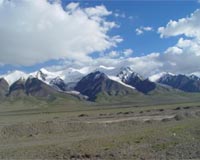 |
Fortaleza, Brazil (AFP) Aug 16, 2010 The United Nations Monday launched a campaign to save the planet from deserts that are threatening a third of the planet along with the livelihoods of more than a billion people. The decade-long initiative aims to "reverse and prevent desertification" and to soften the effects of drought in affected areas "to support poverty reduction and environmental sustainability," Luc Gnacadja, the executive secretary of the UN Convention to Combat Desertification, said. Parched land and deserts today are home to one in three people on Earth, or 2.1 billion people, 90 percent of whom are in developing nations. One billion people struggle to find enough food to survive in such inhospitable terrain. According to the UN, such land accounts for 40 percent of the planet's land surface, and supports a third of all crops and half of all livestock. The proportions of the problem require a global response, UN chief Ban Ki-moon said. "More than two billion people live in the world's drylands. The vast majority live on less than one dollar a day and without adequate access to freshwater," he said. An area the size of Greece, or of Nepal, is lost every year to desertification and soil erosion, the world body said, equivalent to 42 billion dollars in annual income. Climate change is seen as the main cause of the phenonemon, a view reinforced by droughts and flooding in different areas of unusual intensity. Projections based on climate change suggest half the world's population will be living in areas of badly limited water supplies by 2030, according to the UN Convention to Combat Desertification (UNCCD). By 2050, there could be three billion more mouths to feed on the planet, adding to the need to rescue degraded drylands, it said. Although the issue appeared insurmountable, encouraging progress has been made in certain regions, the body said, greatly improving the lives of people living there. One such area was the Loja mountains in southern Ecuador, which was 80 percent eaten up by desertification. An ingenious program to plant cactus there has stalled erosion and protected woodlice populations which cycle nutrients into the soil. Another is in Kenya, where rain-water management and changes to farm techniques has helped stop endemic desertification. "We only used to hear of such projects, but now I am growing my own sorghum. At least I don't have to beg for food all the time," one farmer, Lotira Nyadit, was quoted as saying by the UNCCD. The campaign of the Decade for Deserts and the Fight against Desertification was launched in the northern Brazilian city of Fortaleza, during a UN climate conference that was also preparing a 2012 UN meeting in Rio on the environment and development.
Share This Article With Planet Earth
Related Links Climate Science News - Modeling, Mitigation Adaptation
 China aims to stop desertification in Tibet by 2010: state media
China aims to stop desertification in Tibet by 2010: state mediaBeijing (AFP) June 18, 2009 Authorities in China aim to halt the spread of the desert in Tibet by next year, hoping to stem the effects of years of mining, tree-felling and overgrazing, state media said Thursday. Desertification is spreading by 39,600 hectares (98,000 acres) annually in Tibet, an official at the regional forestry bureau was quoted as saying by the Xinhua news agency. Sangye Drawa said Tibetan ... read more |
|
| The content herein, unless otherwise known to be public domain, are Copyright 1995-2010 - SpaceDaily. AFP and UPI Wire Stories are copyright Agence France-Presse and United Press International. ESA Portal Reports are copyright European Space Agency. All NASA sourced material is public domain. Additional copyrights may apply in whole or part to other bona fide parties. Advertising does not imply endorsement,agreement or approval of any opinions, statements or information provided by SpaceDaily on any Web page published or hosted by SpaceDaily. Privacy Statement |